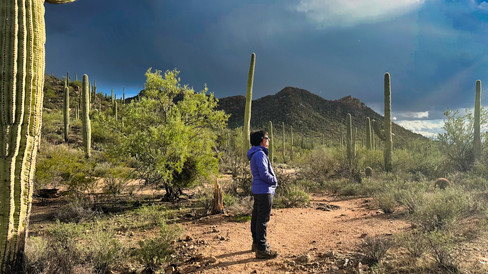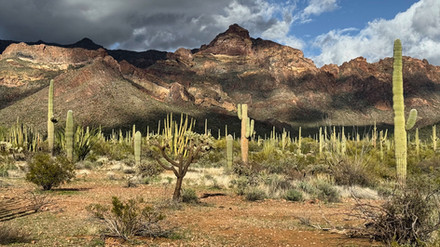Fun in the Desert
- dougsmith51
- Feb 15, 2024
- 5 min read

After our initial cross-country dash, we were finally able to settle in for some quality time in Arizona and Southern California. Our first stop was Tucson, a city we love and a place the Ciaowagen had been to several times in the last six years. We stayed at our usual haunt, Desert Trails RV Park, because of the friendly community there and also because we could hike directly into the desert from the campground.

Saguaros (pronounced "Sa-WAHR-ohs") are a big attraction (no pun intended), and they come in many different shapes.


Even when they die, saguaros are able to maintain their classic shape for a while.

Other cacti also abound in the area, including prickly pears . . .

. . . and chollas with sharp spikes.

In addition to hiking in the campground's desert trails and adjoining Tucson Mountain Park, we visited both sections of Sequoia National Park. The western section is more mountainous, with dramatic views.
The Rincon section, east of Tucson, is flatter. It also hosts many more visitors with its paved loop drive (the western section has just dirt roads).

One day, we visited Sabino Canyon on the outskirts of Tucson. Maintained by the U.S. Forest Service, it's beautiful and quite popular with the locals.

After taking a tram up through the canyon...

...we hiked back down the four-mile road to the visitor center, traveling alongside Sabino Creek where recent rains has caused water levels to rise, making crossing bridges a wet affair.
We'd had a few minor electrical issues crop up during the first part of our journey (e.g., the RV's horn wouldn't work, one of the turn signal connections to the Fittata wouldn't flash), but with the help of some handy campground neighbors, we managed to get them fixed before we departed Tucson.
Then it was on to Ajo, Arizona for two days, where we visited nearby Organ Pipe Cactus National Monument. We'd been here once before during fall 2020 as we visited parks that had been closed when COVID first struck in the spring.
The national monument takes its name from the organ pipe cactus, whose range is mainly in Mexico but extends just beyond the border into the national monument. You see how apt the name is when you see one in person.

At the visitor center, we learned about the senita cactus, which looks similar but whose arms have fewer flutes, a waxier surface, and hairy tops.


To view the senita, we had to drive to the southernmost part of the park. Here, we ran into the border and... "the Wall." When Trump was looking to build sections of his wall, this was an easy place to start since the government already owned the land.
The main months to visit the national monument are December thru March. It gets VERY hot in spring through fall. We saw several of these emergency drinking water stations, highlighted by blue flags, as we drove around the park.

Returning to the area of the visitor center, we hiked the beautiful Desert View Trail, where organ pipe and other cacti (e.g., tiny "hedgehog") abound.
We also drove the park's 21-mile Ajo Mountain Drive which offers many stunning vistas of desert plants, stone arches, and stretches of flat desert reaching to the mountains of Mexico beyond.
It was time to move on again, west and north to Joshua Tree National Park in California. We'd been there before, but this was a first visit for the Ciaowagen. We spent two nights in the park's Black Rock Campground.
The park is named for its iconic joshua trees. Although their foliage resembles a cactus, they are actually trees.

We spent two days exploring the park. We first traveled about 30 miles into the park to visit The Cholla Garden. We'd seen chollas in other desert places, but not in such concentration. Beyond stretched a desert valley and distant mountains.

Driving back toward the park entrance, we stopped and hiked the three-mile Split Rock Trail, named for this feature:

Joshua Tree NP has, in addition to its trees, amazing piles of large granite boulders strewn throughout much of the park. The Split Rock Trail travels through one of these landscapes.


On our hike we passed by colorful purple cacti and juniper bushes with their bright blue berries.
Soon after we started hiking we met two sisters from California who lived an hour away but had never visited the national park before. We wound up hiking most of the trail with them.

One interesting geological feature in the otherwise smooth rocks were lines of other rock (called dams) which had intruded into the granite deep underground when cracks were formed by tectonic forces.
Split Rock is one of our favorite trails so far on this trip!

We drove to Keys View, where you can gaze down on the Coachella Valley, Palm Springs, and the huge wind farms in the area. In the picture below, the yellow box highlights the San Andreas Fault which passes through the valley.

It was a clear day, and looking in another direction we could see the salt water Salton Sea (also highlighted in yellow) some 40-50 miles distant. We learned that the Salton Sea stores a huge reserve of lithium, needed for the batteries that will help fuel the transition to clean energy.

As we drove back to our campsite at the end of the day, we were treated to Golden Hour light on the hills as the sun set.

The next morning, we drove back into the park, first visiting the Cap Rock Nature Trail (you can see, in the picture, the rock that gives the trail its name). We talked to a group of climbers preparing for a day of boldering.

In our RV travels, we've stumbled upon a number of destination weddings and wedding photo shoots. There was one at Cap Rock that morning. We felt for the bride, as the temperature was in the 30s and the winds were blowing 20-30 mph. The men in the bridal party were sporting bright white cowboy hats that frequently took flight in the strong winds.
We next drove the Fittata to a trailhead and hiked the Minerva Hoyt Trail through a joshua tree forest.


Minerva Hoyt was a local woman instrumental in having the park set aside as a national monument in 1936 (it became a national park in 1994). The Hoyt trail led us to Hidden Valley, a circular formation where a wall of rocks surround a low place. In the 1800s, cattle rustlers would lead their stolen cattle into Hidden Vally to hide them. We climbed up a narrow trail between boulders to reach the valley and followed a circular trail around the inside. Some snow and frost was left on the ground and the rocks from the previous evening.
We returned along the Minerva Hoyt trail to our car, making the whole trek a four-mile-plus loop.
The next day we drove about an hour south to Palm Springs for a two day visit with an old business school classmate of Doug's, Jeff Jenest and his husband Bob Colangelo.

It was Super Bowl Sunday and we watched the game together on a big screen TV. We also counted the number of times Taylor Swift appeared on camera celebrating in the skybox (it was a large number).
The next day we lunched with Jeff and another business school classmate Paul Kowal...

...fondly recalling old times and sharing how we all try to stay sharp in our 70s.
In the afternoon, Jeff took us on a "homes of the Hollywood stars" driving tour around Palm Springs, which was a favored getaway spot in the 1930s to 1960s. We also stopped for an obligatory picture at the 26-foot statue of Marilyn Monroe.

On Valentine's Day, we headed south to San Diego, where we would park our rig and begin our week-long van tour of the Baja Peninsula in Mexico. More about that in our next blog entry!








































































Comments